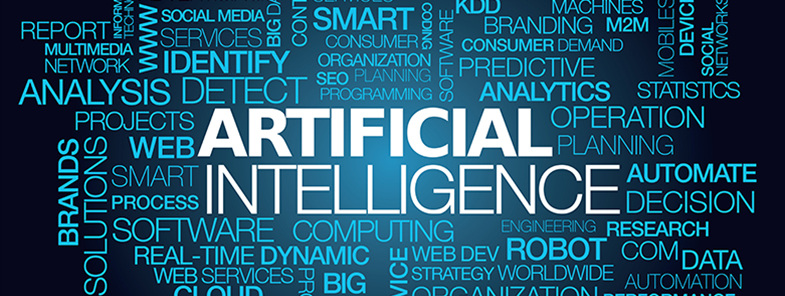"Artificial Intelligence (AI)" covers more territory than many people realize. Compounding potential confusion is the ambiguity of language used to establish AI app categories, and the inability of some to recognize categories in AI at all.
One of the challenges of incorporating AI into existing business procedures is figuring out what sort of a pilot project to start with to prove that applying AI on a larger scale will suit your specific enterprise needs.
Because there are multiple ways in which AI could help any enterprise, one's first impulse might be to take a step back and review all the types of AI software there are besides machine-learning tools and customer-service apps, which are two of the most commonly known uses of AI today, in order to find a different example that would ring true for one's own specific endeavor. But that's where we'd run into a problem, best exemplified by Wikipedia's listing for "artificial intelligence applications."
Wikipedia defines AI apps as having three "technology categories": artificial intelligence, classification algorithms, and machine learning. Clicking on the first of these categories under Wikipedia's definition of AI brings up a list of 39 subcategories, ranging from affective computing to virtual assistants, and including machine learning. Clicking on the second category brings up three more subcategories and links to 86 topical subcategories for the term "classification algorithm" itself. Clicking on the third displays 34 subcategories and links to an additional 200 pages explaining individual terms used in machine learning. It could take hours, or even days, to sort through all these possibilities individually.
Setting quibbles with Wikipedia's accuracy on some topics aside, clearly AI is a shrubbery of many branches. How can we bring more organization to this crowded view?
Paging Commander Data
To begin with, most experts agree AI is divided into three major types of capabilities: narrow (or weak), general (or strong, or true), and super. Basically, narrow defines apps or systems that strictly do what their code tells them and can't learn new behaviors. An example would be early interactive voice-response systems that can respond to a certain number of preprogrammed queries, but questions outside of those have to be referred to a human agent. General AI, in contrast, at least strives to be more human-like, emulating humans well enough that not every person who interacts with them knows they aren't also human. At the top of the scale, Super AI is a hypothetical machine intelligence that could surpass humans and exists only as a conceptual goal (although some might argue that even truly achieving general AI is still mostly a conceptual goal).
Beyond that are the four main "functionalities" of AI, most often specified as reactive machines, limited memory, theory of mind, and self-awareness. Briefly, a reactive machine is computing as we've known it for years: applications that perform a set of functions that can mimic human behavior in some ways but can't learn anything new; they simply perform the same functions over and over when asked. Limited memory is the functional type for most AI applications today: apps have access to a large but finite data set that they've used for training and, in effect, making comparisons and decisions about additional data to which they're exposed. The theory of mind and self-awareness functionalities are still largely conceptual, the first having to do with incorporating assessment of human beliefs and emotions into AI decision-making and the second covering hypothetical machines that can both evoke emotions in human users and possibly might have emotions themselves.
Except…these standard definitions don't really help us categorize different types of AI software, do they? In fact, the narrow-AI "capability" and the reactive-machine "functionality" are arguably barely "AI" at all, instead being computing as we've largely known it for several decades. The super-AI "capability" and the theory of mind and self-awareness "functionalities," aside from a groundbreaking feature or two available today in some AI solutions, are still primarily describing systems that exist only in science fiction.
The Category-Free World of AI Software
Another logical-seeming step in categorizing AI applications might be to seek out some websites that helpfully list AI products.
Let's start with Capterra, an online intermediary between consumers and software producers. If you start at their homepage, they have tons of software categories for general software, but if you look closer, they have only one category for AI: gosh, it's "artificial intelligence software," with no subcategories. If you go to Capterra's AI listings page anyway, you'll find at least 436 products listed, but that list includes anything even vaguely AI-related. Sorting the list by "most reviews" rather than letting the sponsored listings stay at the top of the list, we still see gross differentiation between the software products listed in this single category. Of the first five products listed, the first is an omnibus platform for building and deploying AI apps, the second is a human resources app, the third is a feature within a "project management and accounting platform," the fourth is a geographic information system, and the fifth is a copy-writing app. If you're looking for a machine-learning tool or an app to sort through all the comments your enterprise is getting on social media, let's say, you still have a lot of listings to page through one by one because everything's in the same bucket. Yes, Capterra's site lets you sort by individual features, or deployment platforms, or user types, but there's certainly no "machine-learning tools" or "social-media comment analysis app" categories. If you'd like to see AI apps broken into subgroups, this isn't the place to go.
360Quadrants is an online software comparison site that offers evaluations of the products listed, according to the company's methodology. Going to this company's artificial intelligence listings shows they have a problem similar to Capterra's, judging by the first half-dozen entries. The first product has to do with telemetry collection, the second is a machine training service rather than an app, the third is a business meeting and event scheduling app, the fourth is an HR app, the fifth is a marketing bot, and the sixth one is an app for mortgage refinancing. Once again, we only know all these products have something to do with AI, but the listings don't discriminate between tools and apps and other software types, and there's no way to specify "show machine learning tools only" or really to sort the application packages in any way at all. The interested party has to click on each product's website individually to get beyond each thumbnail product description to find out what kind of an app each product is.
GoodFirms, a company that researches the software market for useful technologies and trends, has an AI products page that similarly lumps together ML tools, AI app-building tools, and AI apps into one big happy family.
A number of other online sources have similar problems.
Apparently, conventional wisdom has it that AI is such a "young" market that it hasn't had time to develop all the useful categories that the mainstream computer software market has enjoyed for years. One has to wonder why that is, because the number of companies producing AI apps, development tools, deployment and management systems, and machine-learning aids (not to mention related services), was 2,028 in 2018 according to one source, although a census for 2021 is not yet available.
Toward a Standardized List of AI Product Categories
There's a need in the AI market to sort all AI offerings into buckets at least similar to those that have served in the past for regular software—for example, tools for building and deploying, tools for app training, and apps that are broken down by what business functions they fulfill, even though some can be deployed in enterprises serving nearly every market. We have to call these buckets "categories" because, as we've seen, "capabilities" and "functionalities" are already spoken for in today's AI market lexicon. Although current software categories developed over years as the computer industry grew in its capabilities, AI is already mature enough that it would be useful to have more categorization for that aspect of computing.
So far there doesn't seem to be any source that has undertaken this classification problem, ironic in that so many AI apps do their work by putting data into categories. Why has no one apparently applied this concept to the overall AI software market itself?
There are a couple of websites and blogs that are making interesting suggestions, but none have been adopted marketwide.
A blog at Newgenapps.com (subsequently taken down) divided AI apps into 11 general categories: chatbots, eCommerce, workplace communication, HR management, healthcare, cybersecurity, logistics and supply chain, sports betting, manufacturing, hospitality, and retail. This isn't complete, but it's a reasonable start.
G2.com, a peer-to-peer software review site, posits eight major AI software categories: AI and machine learning operationalization, machine learning operationalization, machine learning, conversational intelligence, data labeling, data science and machine learning platforms, and deep learning. This seems like a step in the right direction.
Unfortunately, from the names G2 gives these categories, they seem to overlap. Even more confusing are different listed qualifications that products have to meet to appear in a category, and those qualifications also overlap, or worse. The "AI and machine learning operationalization" category requires listed products to "offer a platform to monitor and manage machine learning models, allow users to integrate models into business applications across a company, track the health and performance of deployed machine learning models, and provide a holistic management tool to better understand all models deployed across a business." The "machine learning operationalization" category requires products to fulfill exactly the same qualifications stated in exactly the same words, yet under both of these categories, different products are listed. To qualify under the "data science and machine learning platforms" category, a product must "present a way for developers to connect data to the algorithms for them to learn and adapt, allow users to create machine learning algorithms and/or offer prebuilt machine learning algorithms for more novice users, and provide a platform for deploying AI at scale."
In contrast, the "machine learning" category requires listed products to "offer an algorithm or product that learns and adapts based on data, be the source of intelligent learning capabilities for applications, consume data inputs from a variety of data pools, and provide an output that solves a specific issue based on the learned data." This category lists products not found under the other two categories, but the differentiation between these three example categories isn't too clear.
This web page also has a diagram that shows AI apps divided into seven categories: machine learning (with subcategories of predictive analysis and deep learning), speech (with subcategories of text-to-speech and speech-to-text), vision (with subcategories of image recognition and machine vision), natural-language processing (with subcategories of classification, translation, and data extraction), and additional categories of expert systems, planning and optimization, and robotics (each with no subcategories). These seem like helpful subdivisions, yet the site's own product listings don't actually assign AI application software to any of these categories.
Nonetheless, G2.com seems to be at least starting to provide a clear-eyed division of AI software apps into more useful categories than an omnibus "artificial intelligence software" designation.
Clearing It Up
Hopefully, over the next few years, this classification problem will get sorted out, as it did in years past for more general types of application software. Anyone interested in AI would benefit from the additional clarity that could result.























 More than ever, there is a demand for IT to deliver innovation. Your IBM i has been an essential part of your business operations for years. However, your organization may struggle to maintain the current system and implement new projects. The thousands of customers we've worked with and surveyed state that expectations regarding the digital footprint and vision of the company are not aligned with the current IT environment.
More than ever, there is a demand for IT to deliver innovation. Your IBM i has been an essential part of your business operations for years. However, your organization may struggle to maintain the current system and implement new projects. The thousands of customers we've worked with and surveyed state that expectations regarding the digital footprint and vision of the company are not aligned with the current IT environment. TRY the one package that solves all your document design and printing challenges on all your platforms. Produce bar code labels, electronic forms, ad hoc reports, and RFID tags – without programming! MarkMagic is the only document design and print solution that combines report writing, WYSIWYG label and forms design, and conditional printing in one integrated product. Make sure your data survives when catastrophe hits. Request your trial now! Request Now.
TRY the one package that solves all your document design and printing challenges on all your platforms. Produce bar code labels, electronic forms, ad hoc reports, and RFID tags – without programming! MarkMagic is the only document design and print solution that combines report writing, WYSIWYG label and forms design, and conditional printing in one integrated product. Make sure your data survives when catastrophe hits. Request your trial now! Request Now. Forms of ransomware has been around for over 30 years, and with more and more organizations suffering attacks each year, it continues to endure. What has made ransomware such a durable threat and what is the best way to combat it? In order to prevent ransomware, organizations must first understand how it works.
Forms of ransomware has been around for over 30 years, and with more and more organizations suffering attacks each year, it continues to endure. What has made ransomware such a durable threat and what is the best way to combat it? In order to prevent ransomware, organizations must first understand how it works. Disaster protection is vital to every business. Yet, it often consists of patched together procedures that are prone to error. From automatic backups to data encryption to media management, Robot automates the routine (yet often complex) tasks of iSeries backup and recovery, saving you time and money and making the process safer and more reliable. Automate your backups with the Robot Backup and Recovery Solution. Key features include:
Disaster protection is vital to every business. Yet, it often consists of patched together procedures that are prone to error. From automatic backups to data encryption to media management, Robot automates the routine (yet often complex) tasks of iSeries backup and recovery, saving you time and money and making the process safer and more reliable. Automate your backups with the Robot Backup and Recovery Solution. Key features include: Business users want new applications now. Market and regulatory pressures require faster application updates and delivery into production. Your IBM i developers may be approaching retirement, and you see no sure way to fill their positions with experienced developers. In addition, you may be caught between maintaining your existing applications and the uncertainty of moving to something new.
Business users want new applications now. Market and regulatory pressures require faster application updates and delivery into production. Your IBM i developers may be approaching retirement, and you see no sure way to fill their positions with experienced developers. In addition, you may be caught between maintaining your existing applications and the uncertainty of moving to something new. IT managers hoping to find new IBM i talent are discovering that the pool of experienced RPG programmers and operators or administrators with intimate knowledge of the operating system and the applications that run on it is small. This begs the question: How will you manage the platform that supports such a big part of your business? This guide offers strategies and software suggestions to help you plan IT staffing and resources and smooth the transition after your AS/400 talent retires. Read on to learn:
IT managers hoping to find new IBM i talent are discovering that the pool of experienced RPG programmers and operators or administrators with intimate knowledge of the operating system and the applications that run on it is small. This begs the question: How will you manage the platform that supports such a big part of your business? This guide offers strategies and software suggestions to help you plan IT staffing and resources and smooth the transition after your AS/400 talent retires. Read on to learn:
LATEST COMMENTS
MC Press Online